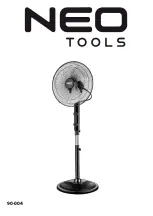
4. MECHANICAL INSTALLATION
ATTENTION!
It is recommended that suitable safety guards form part of the Installation. Such devices, and advice
on safety devices, are available from Fläkt woods limited.
ATTENTION!
Where the fan is delivered in a crate (or similar), the crate must be considered as a protective device
only, and must not be used as a lifting aid unless otherwise indicated.
ATTENTION!
All lifting aids used during installation should be adequately certified to carry the weight of the
equipment being lifted.
ATTENTION!
Always wear appropriate protective clothing (including hard hats, eye protectors and ear defenders)
when working in the vicinity of the fan assembly.
ATTENTION!
During lifting of the fan all personnel must be clear of the area below the suspended fan.
NOTE!
Before installing the fan assembly, check that it has not been damaged in transit, that there is
no deformation of the fan casing, that the impeller rotates freely and that the fan and motor
nameplate data complies with the requirement of its use. If the fan assembly has been stored,
the resistance of the motor windings to earth should be measured (at 500V d.c). If any reading
is less than ten megohms the motor should be dried and re-checked before it is switched on.
Fan assemblies can be heavy (up to 8 tonnes, depending on fan and motor size, with ancillary equipment such
as silencers, guards, bellmouths, adding to the weight), are sometimes unwieldy, and should be lifted slowly to
prevent damage and distortion. Proper precautions must be taken, and certified lifting aids used, to ensure the
fan is well supported and stable before lifting into position.
Flange holes or mounting feet holes can be used for lifting but more than one hole must be used to spread the
load. If special lifting points are provided they must be used. The fan must be installed such that it is correctly
positioned in accordance with the required airflow direction. An airflow indication arrow is shown on the fan
nameplate. For two-stage, contra-rotating fans see Figure 1. Sharp bends in the ductwork close to the fan
must be avoided. Adequate room must be allowed round the fan for inspection and maintenance.
The component parts of the fan assembly, including (if fitted) anti-vibration mounts, silencers, bellmouths,
flexible connectors (and their clips), purlin boxes, weather proofing, platforms, supports, chains and harnesses,
etc. must be fully aligned before being bolted together so that no distortion or stress is placed on the
equipment.
Appropriate fixings, with the correct torque applied, must be used to secure the fan into position. If in doubt
about the torque of a particular fixing, contact Fläkt Woods Limited for advice. The final position of the fan
must be strong and rigid enough to take the weight and operating forces of the fan and any other weight
applied during installation. Vibration isolators, appropriate for the weight and thrust of the fan, are
recommended in order that any fan vibration is isolated to minimise transmission to surrounding fixtures.
If vibration isolators are used, flexible connectors and flexible electrical conduit should also be used. The
vibration isolators and flexible connectors must not be used to align fixing points that are clearly misaligned. If
any component parts do not easily fit together the cause must be investigated and rectified.
Motors are fitted with a drain hole in each end cover, and in the terminal box. The motor drain hole should be
at the lowest point of the motor when it is installed. Plugs that cover the drain holes should either be removed
entirely if condensation is liable to occur due to large variations in operating temperature, or removed
periodically to allow any general build-up of condensation to drain away. The frequency of plug removal will be
dictated by environmental conditions, a record should thus be kept.
Bifurcated fans when mounted on their horizontal axis should have the ‘tunnel opening’ facing downwards
between 3 o’clock and 9 o’clock positions, to minimise the risk of water ingress.
After installation all packing materials must be disposed of in accordance with Paragraph 9.
2






































